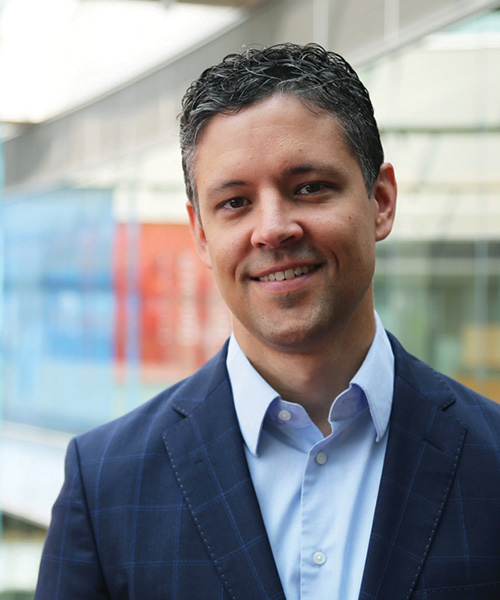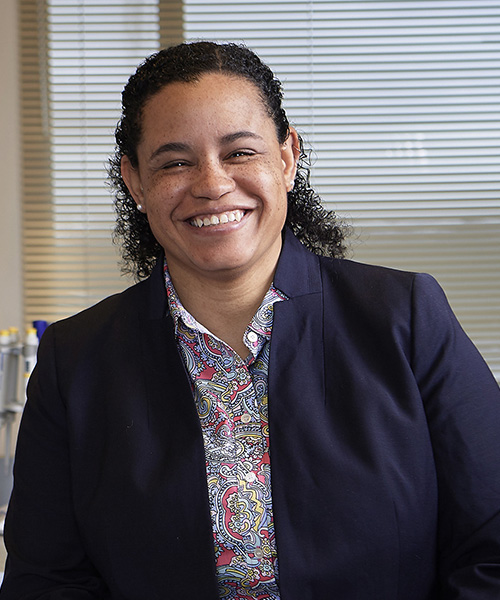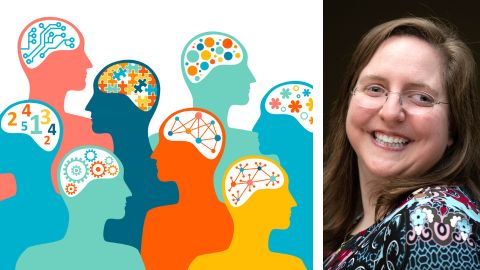Coming soon: Stellar science in the Second City
The 2025 ASBMB Annual Meeting will be held April 12–15 in Chicago, and the two scientists running the show are hard at work making sure the program is filled to the brim with exhilarating science and captivating speakers.
The co-chairs — Donita Brady of the University of Pennsylvania Perelman School of Medicine and Dave Pagliarini at Washington University School of Medicine in St. Louis — talked to ASBMB Today about the cutting-edge science they’re eager to showcase, how to make your annual meeting experience worthwhile and why they think it’s important for investigators and trainees alike to attend.
Their conversation has been edited for length, clarity and style.
Who should attend this meeting?


Pagliarini: The ASBMB meeting can be a profound learning experience for scientists at all career stages. I think this meeting should be attractive to trainees as well as investigators.
I believe that the breadth of this meeting is one of its strengths. It’s a great way to zoom out and experience the broad landscape of biomedical science. Attendees can get exposed to so many topics they would not see at more focused disciplinary meetings.
For me, the meeting always leads to new ideas and new directions. While running our laboratories, it’s easy to get stuck in our lanes. We all need to periodically switch gears and seek out new directions.
Brady: One of the special features of the ASBMB meeting for a trainee is the opportunity to be exposed to different areas of science — especially if you are starting to think about those next steps in your career. If a trainee is unsure about what they want to pursue postgraduate school — a postdoctoral fellowship or a position in academia or industry — they can start to explore that by being exposed to the breadth of science that will be presented at the 2025 ASBMB meeting.
One of the reasons we added some new themes, such as synthetic biology and chemical tools, is to give attendees the opportunity to apply these tools in their typical areas of research and start to think about them in a new way.
Tell me more about the themes you’ve selected for the symposia.
Pagliarini: First, we thought a lot about scientific areas related to our own interests and expertise. A couple of themes are very near and dear to my heart, such as metabolism and biosynthesis, interorganellar communication and molecular movement. I’m always interested in helping bring compelling new stories in my field to the forefront.
We also thought about fields that are rapidly developing because we want these events to be helpful for attendees. We recognize that chemical tools and synthetic biology have broad and expanding utility in the biomedical sciences.
Of course, we also thought about foundational fields with a longstanding presence at the ASBMB meeting.
Brady: When thinking about how to incorporate epigenetic modifications to the genome this year, we decided to focus specifically on the context of cancer biology. We now really appreciate that epigenetic alterations are fundamental to the biology of tumors and avenues for therapeutic targeting.
How did you select the symposia organizers?
Brady: We tried to identify people who have been longstanding leaders in their fields and people who are at the forefront and making new, groundbreaking discoveries.
Pagliarini: We set our sights on theme leaders who are not only excellent scientists but also charismatic, energetic and broad-minded. Any one of these themes could be a multiday stand-alone meeting. There’s so much breadth and ground to cover. We encouraged the organizers to think broadly about how to sample across the full spectrum of their themes.
Do you have any advice for poster presenters?
Pagliarini: It can be hard to know what to expect. You are in a sea of posters and may worry about how to stand out. Just realize that one or two substantive interactions at poster sessions are the big difference-makers. Focus less on trying to promulgate your work to many people and more on fostering a few in-depth conversations that may give you fresh eyes on your science.
What advice do you have for grad students and postdocs planning to attend?
Brady: For the first time, this year we’re going to have a daylong symposium for graduate students and postdocs on Saturday of the meeting. This event is being organized by our journals’ early-career reviewers and will highlight the research of our next generation of scientists, in particular those who will soon be on the job market. Graduate students and postdocs chosen based on their abstract submissions will present their research at the podium and will have the opportunity to receive feedback from peers. This event will also include a panel discussion covering career paths in academia and industry.
Many of us made our very first professional connections and built cohorts as a result of our participation at ASBMB annual meetings, and we want rising stars in the BMB field to make meaningful connections with fellow researchers that will endure for years to come. So we encourage all graduate students and postdocs to start thinking about their abstract submissions as the annual meeting in Chicago provides more presentation opportunities than ever before. You’ll hear more about this event as well as the many other opportunities to meet and network with new and seasoned researchers at poster sessions, meetup events, interest groups sessions and workshops in the coming months.
Pagliarini: Trainees should never hesitate to approach speakers. I remember when I was a trainee, and even a new assistant professor, I’d go to meetings and see well-established speakers gathering together. At first, I felt somewhat excluded. But then I realized, after having a lab for a while, these are just people who are happy to see their colleagues. These meetings are a chance for them to reconnect. But, once you break in, they’re delighted to talk to you. They want to help and welcome you. Often, by taking that brave first step to introduce myself, I began to form connections.
When did you attend your first ASBMB meeting, and what was that experience like?
Pagliarini: My first ASBMB meeting was back in 2003. I was a graduate student in Jack Dixon's laboratory. Jack is a former president of the ASBMB, and he was at the meeting to receive the William C. Rose Award. It was the first time I went to a big international meeting. It was inspiring to see my adviser winning an award, and it really reinforced the importance of the society and why Jack had been so passionate about it. It was why we had often published in ASBMB journals.
Brady: My first ASBMB meeting was in 2021 when I was invited to give a talk. I really loved the meeting because of the breadth of the science it featured and the way it connected to so many areas of research. That's what I loved and why I continue to come back.
It’s been almost eight years since the meeting was last held in Chicago. What should readers know about the location?
Pagliarini: It’s a beautiful, vibrant city. And it is home to many prominent institutions. I think Chicago is quite a gem of the Midwest. It definitely won’t disappoint.
Brady: I am really excited about it as a destination. It’s centrally located, so I hope it will be attractive for those in the Midwest, on the coasts and outside of the United States.
Chicago has a beautiful culture and museums as well as some of the world’s leading institutions. This location will provide an opportunity for the undergraduates in Chicago to attend their first meeting, catch the bug of what it means to be a scientific researcher as well as present their research on a world stage.
For the past couple of years, the ASBMB has invited local students to the meeting for Community Day. Any thoughts on doing it in Chicago?
Brady: It’s our responsibility, as researchers and scientists, to provide that outreach to the public. Any meeting like this, no matter the location, can give back to the community. I think that connection to the area is something Dave and I would love to see as a part of the meeting. There’s an opportunity for us to make a difference in the Chicago community.
About the 2025 co-chairs
Donita Brady is an associate professor of cancer biology, the assistant dean for inclusion, diversity and equity in research training and the vice chair for inclusion and equity of cancer biology at the University of Pennsylvania Perelman School of Medicine. She’s also an associate editor for the ASBMB’s Journal of Biological Chemistry.
The Brady lab studies metalloallostery. They’re defining the mechanistic features of copper-dependent kinases to target them in cancer via drug repurposing or development.
Dave Pagliarini is a professor of cell biology and physiology at Washington University School of Medicine in St. Louis.
The Pagliarini lab is working to define the functions of uncharacterized mitochondrial proteins, identify new gene mutations that underlie human diseases and explore new molecular therapeutics to rectify mitochondria-based disorders.
2025 thematic symposia
Chemical tools to reveal new biology
Organizers: George Burslem, University of Pennsylvania, and Yael David, Memorial Sloan Kettering Cancer Center
Enzymes and pseudoenzymes
Organizers: Shantá D. Hinton, College of William and Mary, and Vincent Tagliabracci, University of Texas Southwestern Medical Center
Host–pathogen interactions
Organizer: Tamara O'Connor, John Hopkins School of Medicine
Interorganellar communication and signaling
Organizers: Navdeep Chandel, Northwestern University, and Isah Jain, Gladstone Institute–University of California, San Francisco
Lipids and membranes
Organizers: Gerry Hammond, University of Pittsburgh, and Judith Simcox, University of Wisconsin
Metabolism and biosynthesis
Organizers: Lydia Finley, Memorial Sloan Kettering Cancer Center, and Gerta Hoxhaj, University of Texas Southwestern Medical Center
Metals of life: From microbes to medicine
Organizers: Sabeeha Merchant, University of California, Berkeley, and Amit Reddi, Georgia Tech
Molecular movement and compartmentalization — Contacts, transporters and nanodomains
Organizers: Nora Kory, Harvard T.H. Chan School of Public Health, and Tim Levine, University College London
Oncogenic hubs: Transcriptional and epigenetic complexes in cancer
Organizers: Cigall Kadoch, Harvard University, and G. Greg Wang, Duke University School of Medicine
RNA biology
Organizers: Sergej Djuranovic, Washington University in St. Louis, and Olivia S. Rissland, University of Colorado School of Medicine
Structural biology of proteins and subcellular structures
Organizers: Christopher Barnes, Stanford University, and Breann Brown, Vanderbilt University
Synthetic biology
Organizers: Vatsan Raman, University of Wisconsin–Madison, and Danielle Tullman–Ercek, Northwestern University
Empowering futures: The transformative power of mentorship in science
Organizers: Nisha Cavanaugh, Sanford Burnham Prebys Medical Discovery Institute; Orla Hart, Purdue University; and Reinhart Reithmeier, University of Toronto
Maximizing access through diversity, equity, inclusion and accessibility
Organizers: Carlos Lopez, Altos Labs Inc., and Teresita (Tere) Padilla-Benavides, Wesleyan University
Enjoy reading ASBMB Today?
Become a member to receive the print edition four times a year and the digital edition monthly.
Learn moreFeatured jobs
from the ASBMB career center
Get the latest from ASBMB Today
Enter your email address, and we’ll send you a weekly email with recent articles, interviews and more.
Latest in Careers
Careers highlights or most popular articles

Embrace your neurodivergence and flourish in college
This guide offers practical advice on setting yourself up for success — learn how to leverage campus resources, work with professors and embrace your strengths.

Upcoming opportunities
Apply for the ASBMB Interactive Mentoring Activities for Grantsmanship Enhancement grant writing workshop by April 15.

Quieting the static: Building inclusive STEM classrooms
Christin Monroe, an assistant professor of chemistry at Landmark College, offers practical tips to help educators make their classrooms more accessible to neurodivergent scientists.

Unraveling oncogenesis: What makes cancer tick?
Learn about the ASBMB 2025 symposium on oncogenic hubs: chromatin regulatory and transcriptional complexes in cancer.

Exploring lipid metabolism: A journey through time and innovation
Recent lipid metabolism research has unveiled critical insights into lipid–protein interactions, offering potential therapeutic targets for metabolic and neurodegenerative diseases. Check out the latest in lipid science at the ASBMB annual meeting.

Hidden strengths of an autistic scientist
Navigating the world of scientific research as an autistic scientist comes with unique challenges —microaggressions, communication hurdles and the constant pressure to conform to social norms, postbaccalaureate student Taylor Stolberg writes.

